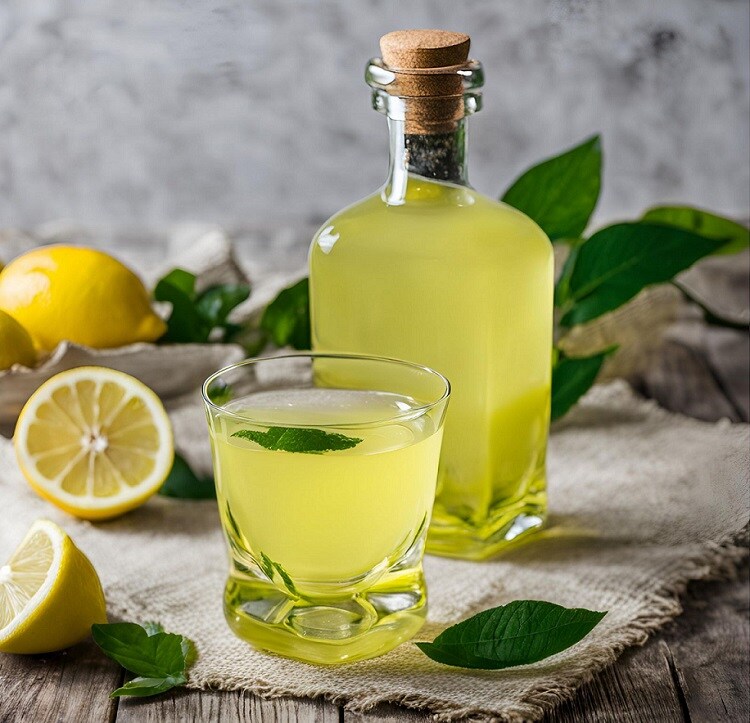LIMONCELLO, also known as limoncino, is a typical Campanian liqueur made with alcohol and untreated lemon peels, with a sweet flavor and characteristic yellow color perfect as a digestif to serve at the end of a meal.
Making this Lemon liqueur is simple and requires only a few easy precautions such as using only untreated lemons, preferably from Sorrento because they are more fragrant and rich in essential oils. You will then need pure alcohol at 95%, which is a solution of ethanol in water with a 95% percentage, and finally a syrup made of water and sugar.
You can prepare Limoncello at any time of the year, although the ideal would be towards the end of May when the lemon peel turns from green to a beautiful straw yellow. The peels will then be macerated in pure alcohol, and after a few days, the mixture is filtered and combined with the sugar syrup. At this point, the limoncino is ready, but before tasting it, I suggest leaving it to rest for about a month in a cool and dry place.
The limoncino should be served strictly chilled, preferably in a frosted glass: the cold enhances the fresh aroma, making its taste unique and inimitable.
But now let’s prepare the homemade LIMONCELLO liqueur together.

- Difficulty: Very easy
- Cost: Medium
- Rest time: 8 Days
- Preparation time: 30 Minutes
- Portions: 2 liters
- Cooking methods: Stovetop
- Cuisine: Italian
- Energy 74.71 (Kcal)
- Carbohydrates 9.24 (g) of which sugars 9.24 (g)
- Proteins 0.07 (g)
- Fat 0.00 (g) of which saturated 0.00 (g)of which unsaturated 0.00 (g)
- Fibers 0.22 (g)
- Sodium 1.17 (mg)
Indicative values for a portion of 40 g processed in an automated way starting from the nutritional information available on the CREA* and FoodData Central** databases. It is not food and / or nutritional advice.
* CREATES Food and Nutrition Research Center: https://www.crea.gov.it/alimenti-e-nutrizione https://www.alimentinutrizione.it ** U.S. Department of Agriculture, Agricultural Research Service. FoodData Central, 2019. https://fdc.nal.usda.gov
Ingredients
- 4 lemons (untreated)
- 500 pure alcohol (95%)
- 1 1/2 cups sugar
- 2 1/2 cups water
Tools
- Jar
- Pot
- Glass bottle
HOMEMADE LIMONCELLO PROCEDURE
Wash the lemons, then with a peeler or a sharp knife, cut the lemon peel being careful to only cut the yellow part and not the white one, as it is bitter. Put the lemon peels in a large glass jar, pour all the alcohol inside, seal tightly with the lid, and let it macerate for four days in a cool and dry place.
After the time has passed, filter everything with a strainer, then prepare the sugar syrup. You will only need to dissolve the sugar in water in a pot and then let it cool. At this point, combine the cold sugar syrup with the alcohol in which the lemon peels have macerated. Transfer everything into two 750 ml bottles. Your limoncello is ready, but before tasting it, wait a month, and if necessary (if it is a bit cloudy) filter it with special paper.

STORAGE
Once the homemade limoncello is ready, it should be stored in a cool and dry place. Given the high concentration of sugars and alcohol, it can be stored well sealed for up to 6-8 months.
NOTES AND TIPS
LEMONS: To obtain a good limoncello, the secret is not in the choice of alcohol or the type of procedure. The thing to pay special attention to is the choice of lemons. Only IGP lemons from Sorrento give the liqueur that characteristic and unmistakable flavor. Also, choose organic to avoid traces of harmful products on the peel. Cut the peel with a sharp knife or a peeler, being very careful to only cut the yellow part and not the white, which is bitter.
ALCOHOL: Which alcohol is best for making limoncello? In the food industry, ethyl alcohol, better known as ethanol, is generally used, as it has the property of harmonizing the components of the beverages in which it is used. For making limoncello, you need pure alcohol at 95%, which is a solution of ethanol in water with a 95% percentage.
HOW TO SERVE LIMONCELLO: Limoncello should be served strictly cold and preferably in a frosted glass. The temperature variation transforms lemon liqueur into limoncello. The cold lets the sweet flavor give way to freshness, enhancing its citrus aroma and making its taste unique and inimitable.
HISTORY OF LIMONCELLO LIMONCINO
Limoncello originates from Campania and is a fragrant and sweet liqueur made with lemons. Its origin is linked to a legend that tells that the Sirens received the recipe directly from Zeus. Others trace it back to a tradition of fishermen who had the habit of warming up on cold mornings by enjoying a glass of lemon liqueur. However, Limoncello began to rise to fame during the Dolce Vita period on Capri, where famous people were used to savoring it in a famous hotel in Capri. Later, the hotelier’s family, to whom the recipe is attributed, decided to register the ‘Limoncello di Capri’ trademark in 1998.
FAQ (Questions and Answers)
When is the best time to make limoncello limoncino
The ideal time for making limoncello is towards the end of May when the lemons take on a beautiful straw yellow color, and their peel is more aromatic and rich in essential oils.
Which alcohol to choose for making limoncino limoncello
Which alcohol is best for making limoncello? In the food industry, ethyl alcohol, better known as ethanol, is generally used, as it has the property of harmonizing the components of the beverages in which it is used. For making limoncello, you need pure alcohol at 95%, which is a solution of ethanol in water with a 95% percentage.

